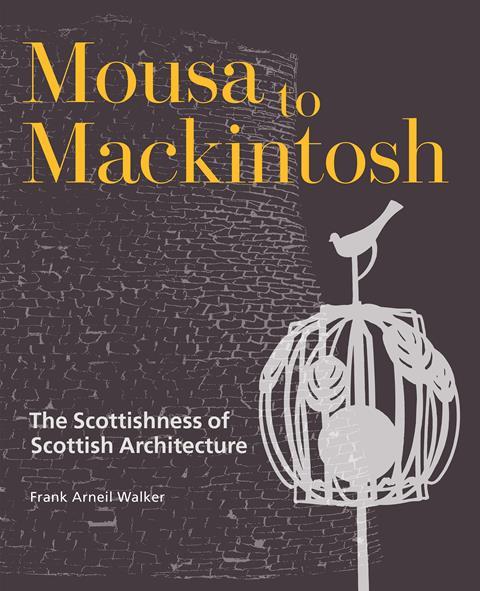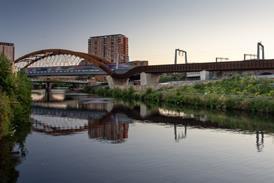Roger Emmerson reviews a new book on the history of Scottish architecture

Scotland, despite local variation, is small enough to have something approaching a unified culture. How then does one define the ‘-ishness’ of Scottish culture? Is it geographic: everything ever imagined, built, performed, painted, danced, sung, spoken or written about within the entity now known as Scotland? Is it aesthetic: everything in that performative enterprise which has utilised identifiable formal means historically embedded in that culture?
Or is it ideational: everything which has been guided by a unique and distinct understanding of the external physical and internal psychic worlds and a response to them conditioned by and recorded in a philosophy? Frank Arneil Walker, author of Mousa to Mackintosh, prefers the aesthetic and ‘[makes] no apology for discussing or evaluating architecture in terms of form [Walker’s emphasis]’.
Within that context, he does so with meticulous scholarship, rigorous exposition of his thesis and vigorous writing in a beautifully produced volume. He has had the benefit of access to the substantial documentary, drawing and photographic archive of his publisher Historic Environment Scotland (HES) and from which the bulk of the very many appropriate and well-chosen illustrations are sourced. The integration of text and image is particularly persuasive and this is a book that should be in the possession of anyone even remotely interested in Scottish culture, let alone in Scottish architecture.
Walker wisely records the tenuous relevance of the prehistoric models of broch, stone circle, chambered tomb or roundhouse to his argument because neither the concept of Scotland nor a unified Scottish culture was present at that time or location. However, it gives to his thesis an ancient countervailing Hyperborean authority to that of the Attic and bridges the rather thin account up to the 11th century.
Such generosity of intent also permits the absorption of Classical architecture within the concept of Scottishness through reference back to older forms such as the Romanesque and its several revivals or, even, continuity in Scotland. Moreover, Walker shows how those Classical architects engaged, albeit tentatively, with ancient castellar forms.
Inevitably in such a study, the towerhouse, the Baronial and Mackintosh loom large as respectively progenitor, prototype and production model and, perhaps, definitive formal markers of a certain response to modernity and its accommodation by the ancient, or vice versa, if you wish. This has coloured understanding of those two poles, the ancient and the modern, in Scottish architecture post-Mackintosh and is where Walker, as have many before him, stumbles.
>> Also read: What did Scotland do for architecture?
He quotes Rober McLeod on Mackintosh’s modernity but only that part of McLeod’s equivocation favourable to his argument. Likewise he misreads Pevsner’s equally equivocal promotion of Mackintosh as a ‘pioneer’. Charles McKean’s unsupported and unproven statistical assertion of the wider prevalence of canonic modernism in 1930s Scotland than in Britain as a whole is no great help either. I have written elsewhere of the fatal attraction of the specious Baronial/Mackintosh/Corbusian-Bauhaus trajectory.
In effect, for Walker, the 20th century seems to have had less to offer in regional Scottish formal responses to canonic modernism than might have been hoped for by proselytisers of the time such as Mansfield Forbes, Robert Hurd and Ian Gordon Lindsay and their later apologist, McKean.
Unfortunately, barring a few signal examples, Walker concludes his thoughts on buildings somewhere around the millennium, pleading necessary avoidance of the historian’s peril of ‘precipitate judgement’; unfortunate due to the subsequent flowering of Scottish architecture in the 21st century where much of his thesis seems to find confirmation although not entirely through formal means.
Other dangers confront the historian. In focussing on the formal, the aesthetic, Walker has set out on a cultural expedition with an incomplete map such that ‘here be dragons’ is signposted rather too often. We are treated to few purely architectural theoretical or philosophical ideas that might stand as guidance in those darker parts of the cultural map.
For example, despite Walker’s favourable discussion of Scotland’s Classicists – perhaps redeemed by their castellar excursions – Alexander Thomson’s sublime neo-Classicism merits less than a page, his rejection of the later Baronial consigning him to relative oblivion. Investigation of some the theoretical concepts embedded in Thomson’s work and in his writings should have secured him a place in that Classical canon and in the context of Scottish architectural form-making generally.
As with McKean and Miles Glendinning before him, Walker dances awkwardly around George Gregory Smith’s (not Hugh McDiarmid’s, he only repeated it) Caledonian antisyzygy, seeing it merely as ‘contrariness’ and missing its polar significance in relation to Scottish culture in particular and its connections to Continental philosophy in general. He also briefly raises the related matter of Pevsner’s notion of a ‘Scottish polarity’ but equally shies away from further investigation as did Pevsner.
On a more general point, one continues to be troubled that a not-inconsiderable output of Scottish architectural history originates under the editorial aegis of HES, a quango of the Scottish Government, where polity must inevitably contest with patrimony. None of the foregoing criticism of some of the detail, however, should detract from Walker’s singular achievement nor from this fine book which contributes much of what has previously been missing in the investigation of the forms of a Scottish architecture.
Postscript
Mousa to Mackintosh: the Scottishness of Scottish architecture, by Frank Arneil Walker, is published by Historic Environment Scotland
Roger Emmerson is the author of Land of Stone: a journey through modern architecture in Scotland, published by Luath Press
















No comments yet